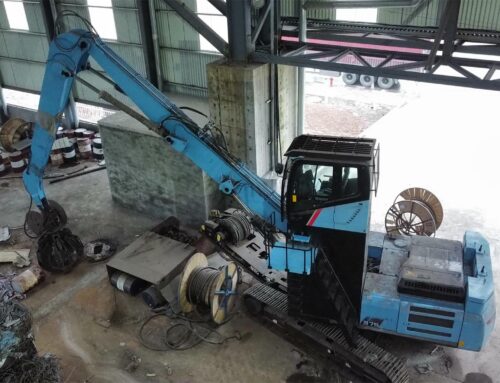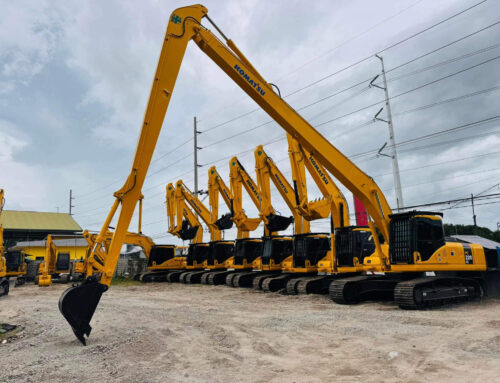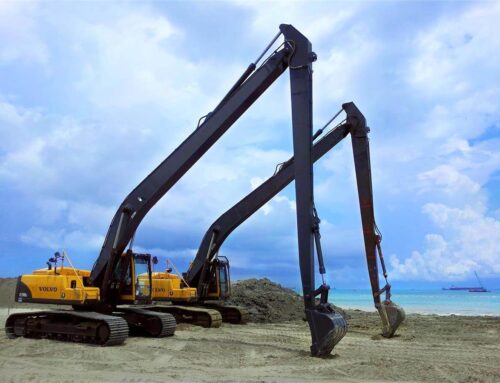Excavators are essential in construction, mining, and demolition, and komatsu excavator long boom attachments extend the excavator’s reach and flexibility, especially for deep digging and high lift tasks. However, komatsu excavator long boom failure and damage can undermine productivity, lead to expensive repairs, and even jeopardize the operator’s safety. The life of this specialized attachment depends largely on usage habits, regular maintenance, environmental conditions, and the structural design of the excavator itself.
Let’s dive into the main causes of komatsu excavator long boom failures, explore common stresses, wear points, and provide solutions that can improve durability and ensure consistent performance.
-
Overloading Beyond Arm Capacity
Problem
One of the most common reasons for komatsu excavator long boom failures is overloading. When operators exceed the recommended weight limit, undue stress is placed on the arm and its connecting joints. This excess weight can cause the arm to bend, crack, or outright break, especially when the excavator is lifted at an awkward angle.
Solution
- Training and Awareness: Proper training on the load limits and operating guidelines of long arm excavators is critical. Operators need to understand that these machines are designed for specific loads, and exceeding these loads will compromise the integrity of the equipment.
- Use auxiliary equipment: In situations where you need to move extremely heavy materials, consider using auxiliary equipment or a shorter, sturdier arm that can handle the load.
-
Inadequate or irregular maintenance
Problem
Maintenance is a major factor in the life of any machine, especially for long-arm excavators that often operate in extreme conditions. Over time, dirt, debris, and moisture build up on the arm’s joints, bolts, and pins, causing corrosion and metal fatigue. Without regular lubrication, these parts face greater friction, leading to faster wear and eventual failure.
Solution
- Routine Inspection and Lubrication: Regularly inspect the arm for signs of rust, wear, and stiff joints. Lubricating joints and connectors will reduce friction and prevent corrosion. Depending on usage, you may need to schedule a daily, weekly, or monthly maintenance routine.
- Implement a preventive maintenance program: Develop a structured maintenance plan that goes beyond reactive repairs. This may include lubricating fittings, checking the hydraulic system, and inspecting the arm structure for any signs of stress or cracks.
- Use quality spare parts: If you need to replace a component like a pin or bushing, invest in quality parts. Low-quality parts are more likely to wear out quickly, leading to repeated repairs.
-
Improper ground conditions
Problem
The ground conditions in which the excavator operates play a major role in the long arm’s service life. Operating in rocky or highly abrasive environments, such as quarries or demolition sites, exposes the arm to constant impact and potential wear. When the arm is pressed against a rock surface or used to break up hard materials, it can weaken or break under the pressure.
Solution
- Attachment upgrades: Consider using specialized attachments designed for heavy-duty environments. For example, buckets with reinforced edges and wear-resistant materials can reduce impact on the arm.
- Strategic digging techniques: Train operators to use gentler techniques when working in challenging conditions, avoiding direct contact with hard or jagged materials whenever possible.
- Monitor and avoid extreme angles: Avoid tilting the arm into unnatural positions in high-impact areas. This can reduce stress on the joints and limit potential damage.
-
Hydraulic system failure
Problem
The hydraulic system is the power source for the excavator arm’s movement. Any interruption in this system, such as leaks, low fluid levels, or pump failures, can result in inconsistent action and excessive force on the arm. A faulty hydraulic system can apply uneven pressure, causing wear on specific parts of the arm, or even complete failure.
Solution
- Regular hydraulic inspections: Make sure to maintain hydraulic oil levels and check for signs of leaks. Replace damaged hoses and seals promptly to prevent inconsistent pressure.
- Monitor cylinder condition: Cylinders are integral to hydraulic function. Check the cylinder for any dents, scratches, or signs of wear, as these can lead to failure.
- Ensure proper fluid quality: Use high-quality hydraulic fluid recommended by the excavator manufacturer. Impurities or low-grade fluids can compromise the entire system, causing uneven pressure distribution and damage to the arm.
-
Operator error and rough handling
Problem
Even experienced operators can sometimes misuse an excavator’s long arm by applying too much force or operating the equipment too roughly. For example, hauling heavy objects with force or using the arm to push debris can overstress the arm, weakening its structure over time.
Solution
- Upskilling Training: Provide ongoing training and instruction on the proper operation of a long-reach excavator. This includes understanding how to operate the machine in challenging environments and when to rely on other attachments or equipment to complete tasks that require additional strength.
- Monitor Operator Activity: Implement tracking tools to monitor usage habits and identify patterns of excessive force. This can help identify areas where additional training may be needed.
Environmental Stressors
Problem
Harsh weather conditions and environmental factors can also cause long-reach failures. For example, working in extreme heat or cold, high-salinity coastal areas, or around chemical pollutants can accelerate wear and corrosion. Temperature fluctuations can cause materials to expand and contract, which can cause microcracks and compromise the structural integrity of the arm over time.
Solution
- Use Protective Coatings: Applying an anti-corrosion coating or paint can add a layer of protection to the arm. Some manufacturers offer coatings specifically designed to withstand harsh environments.
- Climate-Specific Equipment Selection: If you frequently operate in extreme climates, consider choosing equipment designed for those conditions. For example, certain alloys are more resistant to temperature fluctuations and corrosion.
- Storage Considerations: When not in use, store the excavator in a controlled environment to minimize exposure to the elements. This reduces the chances of the arm being exposed to harsh conditions that can cause damage.
-
Weak welds and material fatigue
Problem
Welds and materials used in the komatsu excavator long boom structure are potential weak points. Over time, repeated stress and constant movement can cause fatigue, especially at joints, bolts, and welds. Once the structural integrity of these connections is compromised, it increases the likelihood that the arm will bend or break.
Solution
- Regular structural inspections: During regular maintenance, inspect welds and joints for any signs of cracking or weakness. Even minor flaws can expand under stress, so early detection is key.
- Reinforce welds: If the excavator will be used in a high-stress environment, consider reinforcing critical welds. Consult the manufacturer or a professional technician to ensure that any welding work meets safety and durability standards.
- Use reinforced materials: When purchasing or replacing a komatsu excavator long boom, consider using a high-strength steel alloy with excellent fatigue resistance. Some manufacturers now offer arms made from advanced materials specifically for heavy-duty applications.
Final Thoughts
Komatsu excavator long boom failures can often be prevented with proper training, regular maintenance, and adjusted operating techniques. The key is to understand the limitations of your equipment and recognize signs of wear before they become severe. By proactively focusing on the unique challenges your excavator faces, you can extend the life of your boom, increase productivity, and significantly reduce repair costs.
Implementing these practices will not only minimize the risk of damage, but also maximize the performance of your excavator, ensuring it remains a reliable asset in your operation. Remember, the durability of your boom is not only about the strength of the material, but also reflects how you treat and maintain it.







Leave A Comment